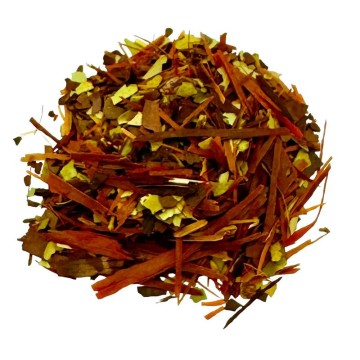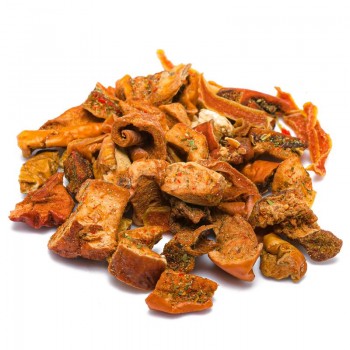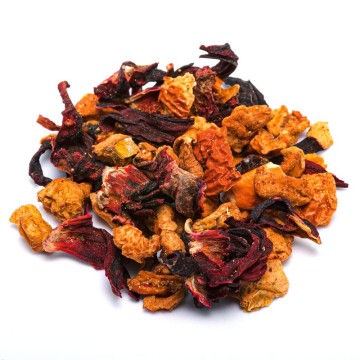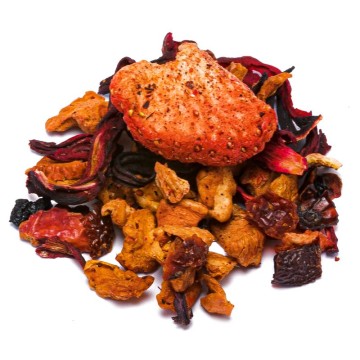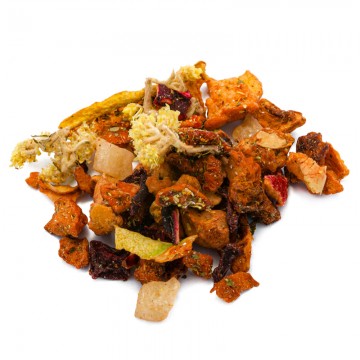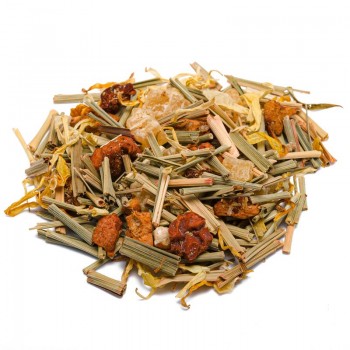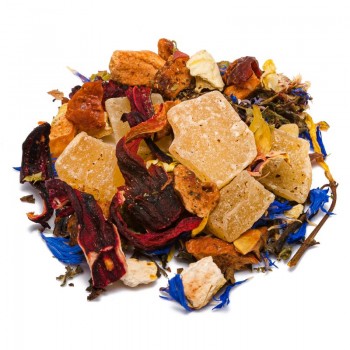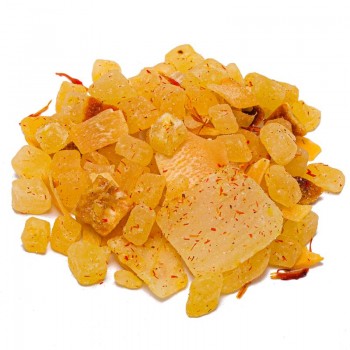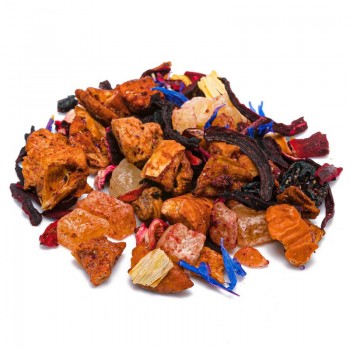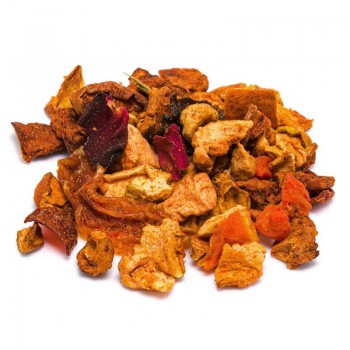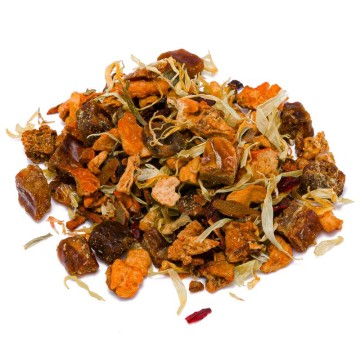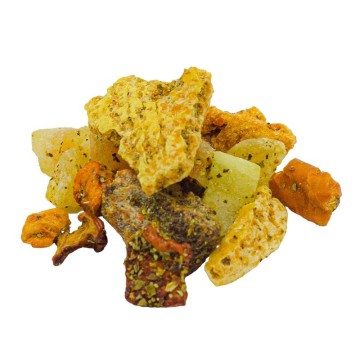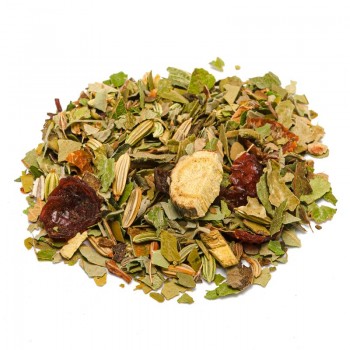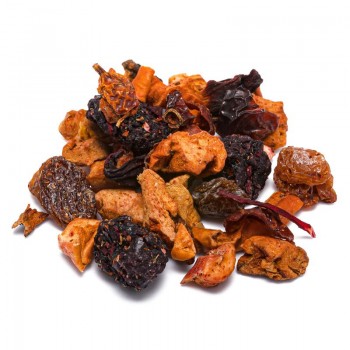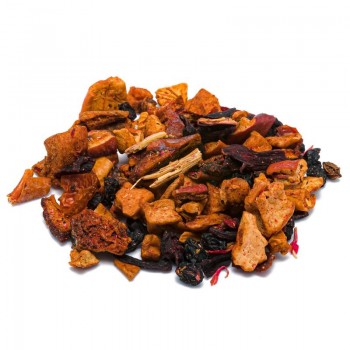The combination of chamomile and pomegranate is embellished with notes of ginger, the floral nuances of hibiscus and sweet blackberry leaves. It might look like a delicious chamomile flavored with pomegranate seeds, if you're looking for an infusion to help you relax at any time. You can interpret its natural taste by enjoying anise seeds and ginger to improve digestion after meals. This exquisite infusion is also perfect for children, for its smooth taste and the nutrients it makes available.
Pomegranate and chamomile infusion: properties and benefits
It is a refreshing drink rich in antioxidants, which help maintain our well-being. The properties of chamomile and pomegranate can help fight against free radicals - harmful to our cells. The element of chamomile can also help improve sleep and digestion, and we know how it is considered a relaxing flower. The antioxidants in chamomile, especially apigenin, promote relaxation and drowsiness. They help improve the quality of sleep and reduce the time we fall asleep if we are nervous or thoughtful. This infusion has useful properties for correct digestion, as we have mentioned. Chamomile, apple, anise seeds and ginger perform useful functions to avoid irritation of the stomach and intestine tract. We know that proper digestion is extremely important for our well-being, and reduces disturbing gastrointestinal conditions (bloating, nausea, intestinal gas, diarrhea or constipation). The infusion helps soothe situations of stomach acidity, favoring good bacteria and reducing those that contribute to gastrointestinal imbalance. The presence of blackberry leaves gives astringent and soothing properties thanks to the tannins - also useful for the well-being of the oral cavity. The beneficial content of pomegranate seeds is added to chamomile, considered a concentrate of vitamins and minerals. Pomegranate plant compounds provide antioxidant polyphenols, which help calm irritation during digestion. They allow you to obtain vitamin C in the infusion, which hibiscus flowers and blackberry leaves are also rich in; as well as some B vitamins and vitamin E contained in ginger. The infusion provides various mineral salts (potassium, phosphorus, magnesium) and is therefore a beneficial as well as relaxing concentrate.
Origins and history of cultivation
Chamomile is a drink known for centuries, which derives from a herbaceous plant with the famous daisy-shaped flowers. Infusing dried flowers in hot water has been consumed as a natural remedy for various health conditions in the past. In reality, when talking about chamomile we must consider that there are two distinct plants. Roman chamomile, which belongs to the Chamaemelum nobile species, is considered true chamomile. It is a perennial plant native to Western Europe and North Africa. The other is German chamomile, or Matricaria recutita, an annual plant native to Europe and Asia. The herbal qualities are similar, which is why both plants have been grown and used equally. They have been associated with sun deities in many ancient religions, for example. in ancient Egypt, chamomile was sacred to the sun god Ra. By the Romans, as by the ancient Germans and Anglo-Saxons, chamomile flowers were appreciated as a valid medicinal remedy. Medieval herbalists selected double-flowering varieties of chamomile to enhance the healing parts of the plant. Chamomile plants are popular as low-growing lawn plants throughout Europe and parts of North America. The pomegranate shrub has an oriental origin, and its presence can be found in historical and literary testimonies dating back to 4000 BC. (named from the Bible, Koran, Homeric Hymns, Mesopotamian documents, etc.). Its original region is probably Persia, modern-day Iran, and the western Himalayas. It spread over time both in Europe and in China, brought along the Silk Road. Known as a symbol of abundance and posterity, it was prized by kings and pharaohs, even as an emblem of eternal life. The pomegranate had many uses as a nutritious food, but also as a tonic to kill parasites.
Fruits and flowers
The components of the infusion are many, and the mixture includes fruit, leaves and flowers of various origins. The pomegranate shrub, Punica granatum, is part of the Lythraceae family. It is a small deciduous tree or large shrub, in any case it gives red flowersand a fruit with white pulp inside and a thick skin outside. The pulp is full of seeds, even hundreds. Pomegranates are grown both as a fruit crop and as ornamental trees for parks and gardens. They tolerate drought and moderate frost, growing well in Mediterranean, California, or northern Indian climates. There are differences that affect the size, the color of the peel and the aril, the hardness of the seed, the juice content, etc. Chamomile belongs to the Asteraceae family. It can be a Chamaemelum nobile plant (Roman or English chamomile) or Matricaria chamomilla (German chamomile). It grows easily throughout the world, as the small, hardy plants naturalize wherever their seeds find a sunny place to take root. It shows white flowers in the head, while the disc flowers are yellow. They are scented, thanks to the essential oil which gives a characteristic smell. Anise derives from Pimpinella anisum, an annual and aromatic plant belonging to the Umbelliferae family. Anise is one of the oldest medicinal plants, up to 50 cm tall, with white flowers and small green to yellow seeds that ripen from August to September. Zingiber officinale is the ginger plant, of the Zingiberaceae family. It is a plant that has a thick, branched rhizome (underground stem), with a brown outer layer and a yellow center. The rhizome gives the spicy and citrus aroma we know, ginger. The Malus domestica plant of the Rosaceae family gives us apples. It is a tree native to Asia, now widespread throughout the planet. The fruits vary in color and in many varieties, and have been used in human nutrition for millennia. The blackberry is the fruit that derives from the bramble Rubus Fruticosus L. and belongs to the large Rosaceae family. It grows spontaneously in Mediterranean countries as a perennial and thorny plant, which creates the classic blackberry thickets. The hibiscus plant is Hibiscus sabdariffa, also called Roselle, of the Malvaceae family. It is an edible plant, which grows in tropical and subtropical regions around the world. If the leaves are consumed as a vegetable, the calyx and flowers are used as flavourings, colorings and for the preparation of hibiscus tea.
Nutritional values of pomegranate and chamomile infusion
The main active ingredients are the antioxidants polyphenols, provitamin A and vitamin C and mineral salts such as potassium, phosphorus, magnesium. How to use the ingredients in the infusion The pomegranate and chamomile infusion is obtained by placing approximately 3-5 grams of the mixture in water at a temperature of 100 °C in a cup (250 ml). Leave to infuse for 10 to 12 minutes before drinking. Add honey or sugar, if desired.
Pomegranate and chamomile infusion: side effects and contraindications
Even if it brings benefits, it is necessary to respect the recommended doses for the mixture and not exceed consumption for too long periods. Excessive intake can cause constipation, nausea, headache, excessive drowsiness and stomach pain. Furthermore, chamomile with its sedative effect could interfere with other medications or herbal teas. Therefore, it is recommended to consume the infusion in the evening before going to sleep. An evaluation of all ingredients is recommended for those suffering from food allergies. Caution advised for pregnant or breastfeeding women.

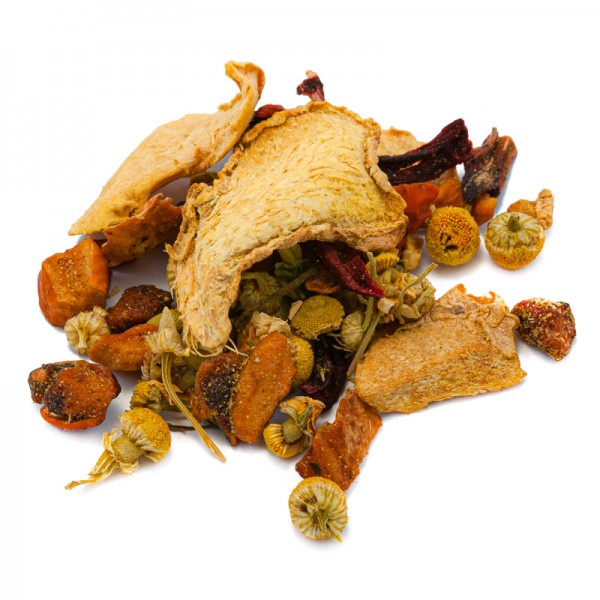









 No reward points for this product.
No reward points for this product.
